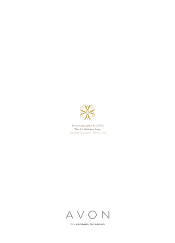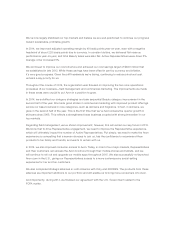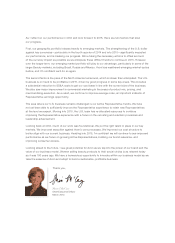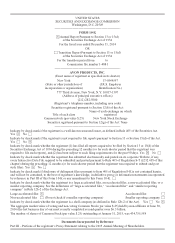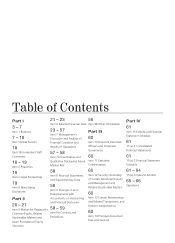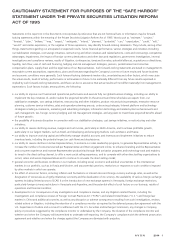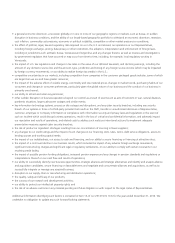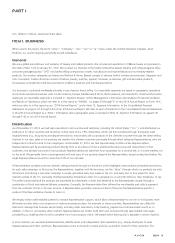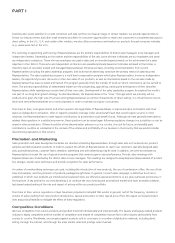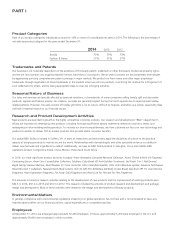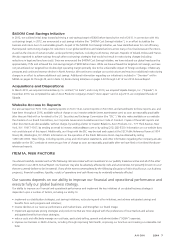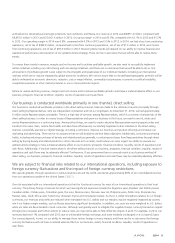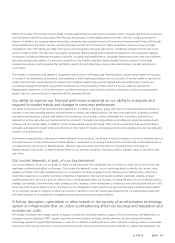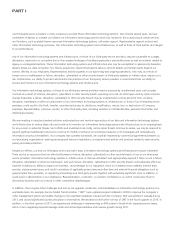Avon 2014 Annual Report Download - page 12
Download and view the complete annual report
Please find page 12 of the 2014 Avon annual report below. You can navigate through the pages in the report by either clicking on the pages listed below, or by using the keyword search tool below to find specific information within the annual report.PART I
branches also create visibility for us with consumers and help reinforce our beauty image. In certain markets, we provide opportunities to
license our beauty centers and other retail-oriented and direct-to-consumer opportunities to reach new customers in complementary ways to
direct selling. In the U.S., U.K. and certain other markets, we also utilize e-commerce and market our products through consumer websites
(e.g., www.avon.com in the U.S.).
The recruiting or appointing and training of Representatives are the primary responsibilities of district sales managers, zone managers and
independent leaders. Depending on the market and the responsibilities of the role, some of these individuals are our employees and some
are independent contractors. Those who are employees are paid a salary and an incentive based primarily on the achievement of a sales
objective in their district. Those who are independent contractors are rewarded primarily based on total sales achieved in their zones or
downline team of recruited, trained and managed Representatives. Personal contacts, including recommendations from current
Representatives (including the sales Leadership program), and local market advertising constitute the primary means of obtaining new
Representatives. The sales Leadership program is a multi-level compensation program which gives Representatives, known as independent
leaders, the opportunity to earn discounts on their own sales of our products, as well as commissions based on the net sales made by
Representatives they have recruited and trained. This program generally limits the number of levels on which commissions can be earned to
three. The primary responsibilities of independent leaders are the prospecting, appointing, training and development of their downline
Representatives while maintaining a certain level of their own sales. Development of the sales Leadership program throughout the world is
one part of our long-term growth strategy. As described above, the Representative is the “store” through which we primarily sell our
products and, given the high rate of turnover among Representatives (a common characteristic of direct selling), it is critical that we recruit,
retain and service Representatives on a continuing basis in order to maintain and grow our business.
From time to time, local governments and others question the legal status of Representatives or impose burdens inconsistent with their
status as independent contractors, often in regard to possible coverage under social benefit laws that would require us (and, in most
instances, the Representatives) to make regular contributions to government social benefit funds. Although we have generally been able to
address these questions in a satisfactory manner, these questions can be raised again following regulatory changes in a jurisdiction or can be
raised in other jurisdictions. If there should be a final determination adverse to us in a country, the cost for future, and possibly past,
contributions could be so substantial in the context of the volume and profitability of our business in that country that we would consider
discontinuing operations in that country.
Promotion and Marketing
Sales promotion and sales development activities are directed at assisting Representatives, through sales aids such as brochures, product
samples and demonstration products. In order to support the efforts of Representatives to reach new customers, specially designed sales
aids, promotional pieces, customer flyers, television advertising and print advertising may be used. In addition, we seek to motivate our
Representatives through the use of special incentive programs that reward superior sales performance. Periodic sales meetings with
Representatives are conducted by the district sales or zone managers. The meetings are designed to keep Representatives abreast of product
line changes, explain sales techniques and provide recognition for sales performance.
A number of merchandising techniques are used, including the introduction of new products, the use of combination offers, the use of trial
sizes and samples, and the promotion of products packaged as gift items. In general, for each sales campaign, a distinctive brochure is
published, in which new products are introduced and selected items are offered as special promotions or are given particular prominence in
the brochure. A key priority for our merchandising is to continue the use of pricing and promotional models and tools to enable a deeper,
fact-based understanding of the role and impact of pricing within our product portfolio.
From time to time, various regulations or laws have been proposed or adopted that would, in general, restrict the frequency, duration or
volume of sales resulting from new product introductions, special promotions or other special price offers. We expect our broad product
lines and pricing flexibility to mitigate the effect of these regulations.
Competitive Conditions
We face competition from various products and product lines both domestically and internationally. The beauty and beauty-related products
industry is highly competitive and the number of competitors and degree of competition that we face in this industry varies widely from
country to country. Worldwide, we compete against products sold to consumers in a number of distribution methods, including direct
selling, through the Internet, and through the mass market retail and prestige retail channels.


